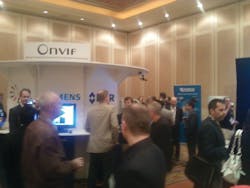ONVIF held its fifth interoperability demonstration at ISC West on Thursday. The event, which is ONVIF’s 3rd such event at the Las Vegas show, offered the opportunity for the security industry to interact with companies actively involved in the development and implementation of the ONVIF specification.
Companies that took part in the demonstration included network video firms Arecont Vision, Axis, Bosch, CNB Technology, DRS RSTA, FLIR Systems, March Networks, Schneider Electric, Siemens and Shenzhen Wision Technology Holdings Ltd.
End-users and integrators were able to see first-hand how simple it is to plug in any camera into another VMS using the ONVIF standard. “This is so good for integrators and end-users to see that the specification is really there,” said speaker Jonas Andersson, Chairman of ONVIF’s steering committee. “It’s one thing to read or talk about it, but to see the products and see it really happening, it makes it easier to rely on it and start specifying. That’s why it is important to demonstrate it.”
Andersson’s speech keyed on a few of ONVIF’s ongoing initiatives, including an access control specification and its new “Profile S” for easier management of interoperable devices.
Profile S describes the common functionalities shared by ONVIF-conformant video management systems, cameras or encoders that sends, configures, requests or controls the streaming of media data over an IP network. The profile includes specific features such as pan/tilt/zoom control, audio streaming and relay outputs.
“Our introductions of profiles will become even more important as ONVIF moves into the access control arena with our planned released of the access control specification this year,” said Andersson. “The profiles will help end-users to understand which unit to select.”
For example, end-users will no longer need to know whether specific devices in ONVIF 2.0 are compatible with clients that conform to ONVIF 1.0, or with newer versions of the specification introduced in the future. Instead, users and systems designers will be able to select the appropriate profile that offers interoperability at a specific functional level between units and software that fits their needs.
As for the access control specification, Andersson said the group is progressing closer to releasing it, but work is still being done. He cited new ONVIF member Assa Abloy as having a key role in the development of the spec.
Andersson added that events like the ISC West plugfest provide additional tangible benefits, as experienced end-users and integrators toy with the interoperability of the cameras and other technolgies. “Plugfests are very useful, because there are always cases that you haven’t thought about,” Andersson said.
Additionally, there are other, more intangible benefits that go beyond simple “brand recognition.” Said Andersson: “End-users, integrators and vendors that participate (in the plugfest) might get an idea that they would like to do more with – for example, a specification for intrusion alarms has been suggested. Perhaps this event has inspired some company to take the lead on that.”
So what’s on the horizon for ONVIF? Andersson says next year’s ISC plugfest may feature a complete, iontegrated, interoperable ONVIF-compliant security system. “We may see a true integrated system, where you can tangibly see the benefits of having one standard. We want to show the benefits of relying on ONVIF to create a truly integrated system.”
About the Author
Paul Rothman
Editor-in-Chief/Security Business
Paul Rothman is Editor-in-Chief of Security Business magazine. Email him your comments and questions at [email protected]. Access the current issue, full archives and apply for a free subscription at www.securitybusinessmag.com.

